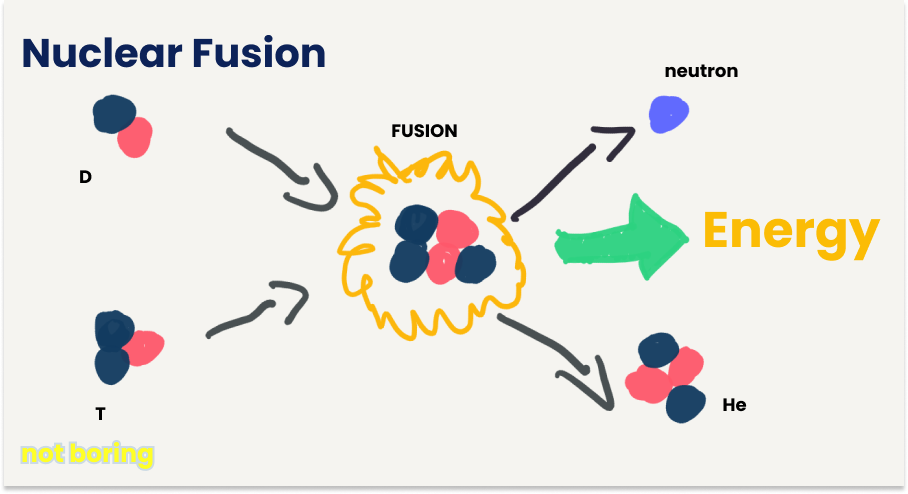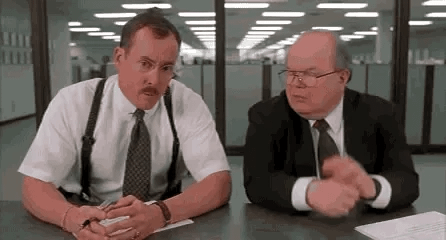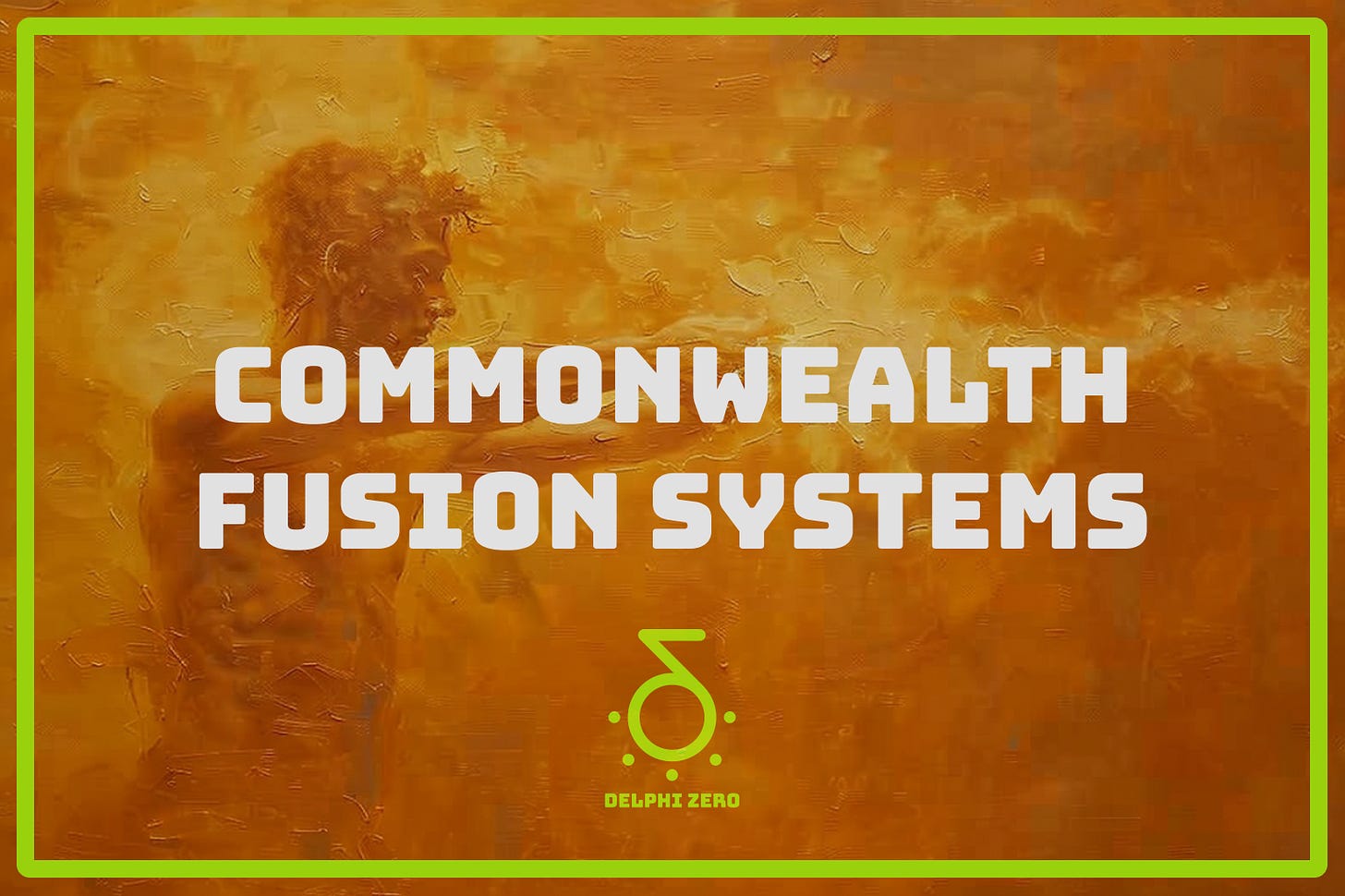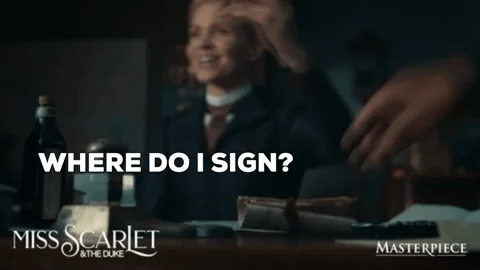Brand Audit in Climate Tech: Commonwealth Fusion Systems
How do you explain that your company recreates a star on earth?
👋 Hello to 2,621 climate buddies 🌳
Climate is not a technology problem but a story problem.
Delphi Zero is a consultancy and newsletter about the narrative potential of climate.
📧 If you are opening this essay in your email inbox, please click on the title 👆 of this piece to enjoy the full-length version in the browser.
Do you ever dread the moment when someone asks you “So… what does your company do?”
If you do, then it’s probably because of a core tension: There is so much to cover but only so little that the other person wants to hear.
Let’s be real, your answer to this questions usually results in one of two things:
If you nail your answer, it can turn into a great conversation and a lasting friendship/partnership
If you don’t, you have a first-row seat to witnessing how your poor, glassy-eyed counterpart scrambles for a “plausible excuse” to move on from this conversation
Ouch!
Regardless of your audience, there’s a great reward to acing these moments. They might be the decisive factor to landing a key hire, securing a strategic partnership, or making an important sale.
I started writing this series to show how companies like yours can do this in practice:
Brand Audit in Climate Tech: Commonwealth Fusion Systems (today’s essay)
Today’s deep-dive is about Commonwealth Fusion Systems - a wild organization that is quite literally stealing fire from the gods so that we can recreate a star on earth ✴️
Let’s see what they do well and what could be improved 👇
Brand Audit in Climate Tech: Commonwealth Fusion Systems
By Art Lapinsch (illustrations generated via Midjourney)
Everyone is the main character in their own life.
When someone asks “So… what does your company do?” they are actually asking “So… what does your company do for me?”
You can break this down into four useful elements:
Hero: Who is the hero of the story? (hint: the hero is always the person who asks)
Desire: What do they want?
Complication: Why can’t they (currently) have it?
Stakes: Why is it important to them?
It’s the common “who wants what? and what’s in their way?” question that master storytellers have used across centuries.
We will reference this framework quite a bit. So get comfy with it.
Commonwealth Fusion Systems and Their Challenge
I picked Commonwealth Fusion Systems (aka CFS) because (a) they are building crazy shit and (b) because they are currently hiring for an external comms lead.
Let’s take this step-by-step.
About the Company
They write:
Commonwealth Fusion Systems (CFS) has the fastest, lowest cost path to commercial fusion energy.
CFS collaborates with MIT to leverage decades of research combined with groundbreaking new high-temperature superconducting (HTS) magnet technology. HTS magnets will enable compact fusion power plants that can be constructed faster and at lower cost. Our mission is to deploy these power plants to meet global decarbonization goals as fast as possible.
tl;dr:
What is fusion? → When we think of “nuclear”, it is usually splitting heavy atoms (i.e. fission) to generate energy. CFS does the opposite. They fuse light atoms together (i.e. fusion) to generate energy. [My friend Ben wrote a super helpful primer to fusion energy. You should read it.]

Commercial fusion reactor: Commercial fusion reactors don’t exist (yet). That’s why a group of former MIT researchers have started CFS to commercialize decades of academic research. The goal of a fusion reaction is to get more energy out of the reaction than you what you put into the reaction. This is expressed by the fusion energy gain factor (Q). We want a Q that is higher than 1 (i.e. Q>1).
Fastest path to commercial fusion → There are different types of fusion reactor designs (see illustration below). CFS uses the Tokamak design, which is currently the most researched and closest to the Q>1 threshold. That’s why CFS claims being on the “fastest path to commercial fusion.”

Let’s practice our framework from earlier:
Hero: Commonwealth Fusion Systems
Desire: Commercial fusion at global scale
Complication: We haven’t achieved Q>1 yet. Unlocking frontier science and accomplishing sci-fi-esque engineering feats is expensive. That’s why CFS plans to demonstrate that their approach works via a pilot project (SPARC). If successful, this will unlock the resources to build the first commercial fusion plant (ARC).
Stakes: Climate change; energy security; etc.
They are looking for help to get this story across 👇
About the Role
As the Head of External Communications reporting to the CMO, this is a highly visible role responsible for bringing our groundbreaking fusion technology to the world stage.
In this role, you will craft compelling messaging and differentiated positioning to drive broad comprehension of fusion's potential as a safe, sustainable power source. You will lead strategic storytelling and executive casting as CFS looks to be recognized as the industry juggernaut and industry statesman.This role will be responsible for accelerating the growth of our global brand, managing our corporate reputation, and elevating CFS as a category-creator in clean, sustainable energy.
Specific Responsibilities
Further, they expand on the responsibilities:
This team member will:
→ Company Narrative: Own the company narrative and be aggressive in capturing tailwinds from the global zeitgeist
→ Strategic Messaging: Develop an audience-specific messaging house and own the document on an ongoing basis
→ Co-founder Communications: Develop a proactive, strategic approach to earned media placement and co-founder communications
→ Issues & Crisis Management: Lead on building a rapid-response crisis communications team able to cover both issues management as well as crisis issues
→ Third-Party Influencers: Working with Open Innovation, Digital and Global Affairs, develop a third-party influencer campaign to identify, curate, manage and activate industry analysts, academics, and other key opinion leaders
→ Metrics: Manage the right set of tools to capture quality of earned media coverage, message pull through and tonality and benchmark against the competition
We will use these elements from the job description to structure the rest of this case study.
Commonwealth Fusion Systems: Brand Audit
It all starts with an audit of the status quo.
Similarly to what I did in the Lilac case study, we start by creating a brand/narrative pyramid - a one pager for CFS’ brand.
You can find relevant information all across the web. I usually start with these sources:
→ Website: The most helpful sites are the main landing page, the /about, the /solutions, and the /careers pages. You can deduce a lot from there (e.g. Vision; Mission; Brand Promise/tagline; Value Proposition; RTBs/Proof Points).
→ LinkedIn: Great to find a standardized boilerplate section on the company.
→ Press Releases and Blog Posts: You can derive brand focus areas via looking for repeating narratives/language/words.
The initial brand audit resulted in this brand/narrative pyramid 👇
How to read this audit:
⚫️ Bold - Cornerstone Keywords
✴️ Orange - Statements that felt important to me
🔴 Red - Possible areas of tension in the narrative
❓ Question Marks - Missing insights, since I couldn’t access this information
My quick-and-dirty analysis of CFS is this:
💪 Strengths
Strong alignment with vision statement: Everything revolves around “limitless, clean fusion energy” which is good.
Strong signature/origin story: Hard to compete with “we developed this at MIT and now we are commercializing it.”
🧐 Opportunities
Shorten and focus the statements: Some of the communication elements like the Mission Statement could benefit from leading with the actual mission (i.e. “commercialize fusion energy…”). Currently, it starts with the problem (i.e. energy demands for clean energy). Don’t burry the lede.
Sharpen the Category: IF Commonwealth Fusion Systems wants to become a “category-creator” THEN it needs to clearly state (a) what the category is and (b) how it is different from other categories. Clean energy is not differentiated enough.
Unclear Target Customer(s): From my initial audit, I couldn’t deduce the target audience. Is it the government? Is it citizens? Is it the scientific community? Who are the heroes?
Expand Proof Points: CFS has strong proof points for its claim of being the “surest path." Yet, it lacks proof for “limitless and clean.” This can be improved.
Overall, CFS does a lot of things very well, which is not surprising for a mature tech company with enormous funding. But there’s always room for improvement.
Let’s take it step-by-step.
Company Narrative
Company Narrative: Own the company narrative and be aggressive in capturing tailwinds from the global zeitgeist
Notes:
Company narrative: My feeling is that CFS is looking for a cohesive story top-to-bottom.
Capturing tailwinds from the global zeitgeist: I kind of get what they are trying to say: “piggy on current news and global trends.” A few thoughts: (a) the phrasing sounds more like something a D.C. think tank would say and not something from an academic spin-off from MIT … there’s a bit of dissonance. (b) There’s nothing wrong with leaning into certain trends (e.g. increased priority for national/energy security; etc.) but if CFS wants to be a category-creator, it must set the tone. What are the trends that are unique from CFS’ perspective? What do they see that the “zeitgeist” hasn’t captured yet?
To create a cohesive company narrative, I updated the brand/narrative pyramid. This is what v2 looks like 👇
The changes/adaptations are highlighted in orange ✴️
Emphasize Mission: Don’t burry the lede. Always start with the mission. In this case, commercializing fusion energy as fast as possible.
Lean into the Origin Story: CFS does this well already. But being able to say that you developed the scientific/academic breakthroughs and now are commercializing is unique. Maybe there’s a way to lean more into the MIT heritage since they have a long history of conjuring impactful technologies (e.g. research at Building 20 during WWII)
Brand Values: I reworked those, since (a) it’s nice to have three instead of four values for easier triangulation, and (b) it’s kinda cool if the values fit into the CFS acronym (Committed. Fast. Scientific.)
Expand Proof Points: The value proposition claims “limitless” and “clean” needs more proof. Think of sub-sites, blog posts, papers, videos, etc. Otherwise, “surest” is the only claim that has very solid proof and it feels a bit lopsided.
I’ll address the sections in red (category/frame of reference; target customer; customer need) in a section below.
Strategic Messaging
Strategic Messaging: Develop an audience-specific messaging house and own the document on an ongoing basis
Ok, let’s unpack this one. I disagree with the phrasing.
The words that irk me are “develop an audience-specific messaging house.”
First, what are we talking about?
CFS asks for a messaging house. It’s an overview of a messaging structure:

Looks familiar? It should, because it’s pretty much what I call a brand/narrative pyramid and what you have seen further above. I tailored my framework specifically to fit tech companies.
So, let’s get back to what CFS is asking: “audience-specific messaging house.”
Let’s assume we have 3 core audiences (and three core promises):
US Government → “Commercial fusion is good for national/energy security.”
Scientific/Talent Community → “Commercial fusion is a frontier technology and might be the most important work of your career.”
Investors → “Invest in the Standard Oil of the future.”
Would that mean creating three distinct messaging houses? I don’t think so. Let me explain.
I’d recommend against it because:
No Single-Source-of-Truth: Having multiple documents risks having diverging messages. Keep the kernels of the message in the same document/SSoT.
Redundancy: At the end of the day, you build brands by keeping a promise over and over again. Across all touchpoints. Across all audiences.
A better way to think about it is a house with windows on different sides.
Depending on which buyer swings by to look at the house, you can show them a different side/angle. But it’s still the same house. You do that by:
Keeping a SSoT: Keep the core info similar across all audiences. [Surest + Limitless + Clean] applies regardless whether you are the US Government, the Scientific/Talent Community, or an Investor.
Mapping the Different Audiences: Create audience personas (e.g. target customer; pain points; talking points). It’s no different from our [hero, desire, complication, stakes] framework.
Adapting the Language: It makes sense to talk differently to each audience. Use the personas and expand them with a glossary of used terminology. A scientist cares about Q while an investor cares about ROI. But the underlying endeavor - building SPARC & ARC - is still the same.
It’s a matter of framing.
For example, this slide is very relevant for some audiences while total overkill for others 👇

Co-Founder Communications
Co-founder Communications: Develop a proactive, strategic approach to earned media placement and co-founder communications
In my last case study about Lilac Solutions, I showed how a brand/narrative pyramid can be used as an editorial roadmap for various “voices”. Regardless whether you’re a founder or a product manager, you can reference the pyramid to derive your talking points.
There are two considerations:
#1: Divide & Conquer
The co-founders focus on different parts of the pyramid. For example:
CEO: Vision & Mission
CSO: “surest path” pillar along all levels (e.g. pain point; value proposition; proof points)
etc…
Different “voices” specialize/focus on specific segments but they can move up/down the pyramid when needed.
For example, the CSO talking to scientific/community would also preface with the signature/origin story. Vice versa, the CEO would be able to go into technical details and proof points despite focusing on the overarching vision.
#2: Multiply by Audiences
Another consideration is to have each co-founder speak to a specific audience. They would cover the entirety of the pyramid but tailor their language to their recipients.
To give better guidance, I would have to understand how the co-founders Bob, Zach, Brandon, and Dan, split their work.
What are their areas of expertise (beyond the boilerplate /about segments on Linkedin)?
In which audiences are each of them already known?
etc.
tl;dr: Lots of opportunities to create many communication touchpoints that remain consistent with CFS’ core message.
Issues & Crisis Management
Issues & Crisis Management: Lead on building a rapid-response crisis communications team able to cover both issues management as well as crisis issues
My guess is that the expectation of CFS is that “if you’re reacting to a crisis it’s already too late.”
Sure, unknown unknowns, by definition, can always happen. But it’s better to have your contingencies planned in advance. Proactively.
Here it’s best not to reinvent the wheel and trust the methods of NASA and the DoD.
Preemptive Red Teaming
Sit down with people from CFS and start collecting a list of things that could go wrong. Rank them by:
Likelihood of risk
Severity of risk
Then, just start working through this list starting with “most likely & most severe” and so on.
Prepare the communication sequences, store them away, and hope you’ll never have to open that folder for the rest of your life.
“We don't rise to the level of our expectations, we fall to the level of our training.”
- Archilochus
Do this exercise at regular intervals. Do sanity checks whether the prepared info is still up-to-date and in-line with the company’s vision.
Third-Party Influencers
Third-Party Influencers: Working with Open Innovation, Digital and Global Affairs, develop a third-party influencer campaign to identify, curate, manage and activate industry analysts, academics, and other key opinion leaders
We have touched different audiences further above (e.g. strategic messaging; and #2 in co-founder comms).
#1: Educating the Market
Beyond those considerations, there’s a proven playbook for branding in technology markets. Mohanbir Sawhney has written the canonical introduction in Chapter 11 of the Kellogg on Branding book.
Long-story short: In technology markets you have to educate the market - especially if you’re introducing new ways of doing things. Mr. Sawhney calls this pre-market branding in opportunity arenas.
In modern marketing this is done via:
Insights/reports/playbooks
Scientific Publications → CFS is doing this already (link)
Webinars/Conferences
Literally, any educational touchpoint you can think of.
Once you identify your heroes and their desire/complication/stakes combinations, you can use the rest of the pyramid to cater to it via various marketing touchpoints.
#2: Awesome Non-Fiction
Present your in-house heroes.
CFS currently works on an unbelievable project - SPARC. That’s killer content.
Do what Google/DeepMind did with their AlphaGo movie. Have a team capture these moments and turn it into a cultural artifact that captures the zeitgeist.
How do you do that? I have some answers in this piece 👇
Metrics
Metrics: Manage the right set of tools to capture quality of earned media coverage, message pull through and tonality and benchmark against the competition
This one will be short.
To give a meaningful answer to this question, you’d have to understand the internal objectives of CFS.
Metrics follow as a result of the overarching goals and don’t exist in a vacuum - unlike certain elements of a fusion reactor.
Remaining Questions ⁉️
What’s missing?
Target Audience
Gun to my head, I wouldn’t know what CFS target audience(s) is/are.
Maybe I’m just too stupid to understand. But I’d encourage CFS to dig a bit deeper and understand who’s your best friend, your second best friend, and so on. Then, start catering to them in your communication.
Lot’s of untapped potential here.
Talking to governments? Great, create a /governments sub-site and showcase that the US Government is involved in CFS via the Department of Energy.
Category
Since CFS wants to be a category-creator, you’d need to define your audience first.
April Dunford - the leading expert in positioning - has a methodology that revolves strongly around a brand’s target audience.
CFS can go down various routes of framing/defining their category.
If it’s fusion startups they could claim that they are one of the best-funded organizations, but they can’t control it. Someone could just raise more money. That’s a problem.

The goal of category creation is to have an unfair advantage that no-one can take away from you. Like in the scientific method, you want something that others can’t falsify easily. Let me give you a practical example.
When I ran my adtech startup - Perengo Inc. - our origin story was that we hailed from the super-techy fringes of the advertising world. We were industry veterans who built programmatic ad platforms in e-commerce, mobile apps, and gaming. But there is an industry that hasn’t started using programmatic yet: Recruitment. Now, we bring this technology to the recruitment market. Copy, paste. Hence, we coined the term Programmatic Recruitment. It didn’t exist before. We were first and there was nothing anyone could do about it. As they say, the rest is history.
I believe that CFS has a lot of potential in framing a category that can be unequivocally theirs.
Before we get to the grand finale, allow me to do a quick public service announcement.
Do You Like What You’re Reading?
If you haven’t yet, sign up to Delphi Zero to receive future case studies like this one.
Do You Need Help?
I consult climate tech companies on getting their brand narratives right.
If you or one of your portfolio companies needs help, ping me on LinkedIn and/or message me 👇
— End of the Commercial Break —
Back to the good stuff.
Commonwealth Fusion System’s Future Mythology ✴️
In the first segment of this series, I said that tech companies are messengers from the future. All of them see something that the rest of us doesn’t see yet. Hence, they can create their own Future Mythology.
Funny enough, it maps perfectly with Andy Raksin’s “The Greatest Sales Deck I’ve Ever Seen” - a 5-step version of the same idea.
So, next time, when a governmental official asks what CFS does, they can answer by:
⛈️ A Change in the World: National security, climate goals, and political stability are currently at odds with each other. Optimize for one and lose out on another.
🏅 Winners and Losers: Governments who master this balancing act will be politically resilient, environmentally clean, and economically competitive. Those who miss the boat will fall behind.
🏞️ The Promised Land: Fusion energy is a path to secure, clean, and abundant energy.
🪄 The Magic Gift: Commonwealth Fusion System’s SPARC project is pushing the frontier closer to commercial fusion.
📑 Evidence: SPARC is just around the corner. It took decades of research and development but Q>1 is within reach.
Want to have a seat at the table? It’s not too late to be early.
This is what you should see after the pitch:
This, my friends, is how you explain that your company recreates a star on earth.
For their benefit.
🙏 Thanks, CFS for stealing fire from the gods and advertising such an interesting position.
Get in touch via Linkedin if you want to chat about ideas, projects, or a potential collaboration✌️














